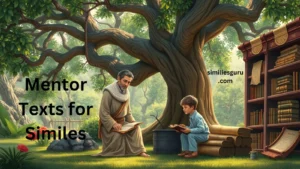Similes are a wonderful way to add depth, creativity, and emotional connection to poetry, especially when writing for children. A simile, as a literary device, compares two things using the words “like” or “as,” making abstract or complex ideas easier to understand. Whether you’re writing a poem for kids or helping young learners appreciate poetry, using similes can transform simple lines into memorable moments.
In this article, we’ll explore a variety of similes used in poems for children. We’ll break them down into different categories, providing both professional and casual alternatives to help you understand how tone affects the way similes can be perceived and used. You will also discover how similes are great for children’s poems by making abstract concepts more tangible and understandable.
We will go through 25+ examples of similes that work wonderfully in children’s poetry, and also provide 13 user-friendly texting examples to show how similes can be applied in modern conversations.
Understanding Similes in Poetry for Kids
Before diving into the examples, let’s explore what makes similes particularly effective in poems for kids.
- Simplicity: Similes break down complex ideas into something kids can relate to. For instance, comparing a feeling to a weather condition, like “as cold as ice,” helps children easily understand emotions.
- Imagination: Children are naturally imaginative, and similes tap into that creativity. “As bright as a star” invites them to visualize something fun and inspiring, enhancing their connection to the poem.
- Engagement: Poetry is about engaging with the audience. Similes invite the child to imagine and even participate in the world of the poem.
Categories of Similes in Poems for Kids
1. Similes for Nature
Nature is often a rich source for similes in children’s poems. From comparing the softness of clouds to the brightness of the sun, similes can make the natural world more vivid for young readers.
- As soft as a cloud
- As bright as the sun
- As green as grass
- As gentle as the breeze
- As tall as a tree
These similes connect children with nature, teaching them to appreciate their surroundings while giving them easy-to-imagine comparisons.
2. Similes for Emotions and Feelings
Using similes to describe emotions makes them more relatable for children. Comparing feelings to something physical, like a warm blanket or a storm, helps children better understand what those emotions feel like.
- As happy as a puppy
- As mad as a hornet
- As scared as a mouse
- As quiet as a mouse
- As sad as a rainy day
These similes allow children to connect emotionally with the content of the poem, and they can be used in stories or poems that discuss happiness, fear, or sadness.
3. Similes for Speed
Similes comparing speed can add action and excitement to poems, especially those that tell stories or involve fast-moving characters, like animals or vehicles.
- As fast as a cheetah
- As quick as lightning
- As speedy as a race car
- As fast as the wind
- As quick as a rabbit
These similes help children imagine movement in a way that feels thrilling and exciting.
4. Similes for Size
Similes that compare size can be fun and playful. Comparing things to giants or tiny creatures can make children laugh and visualize more clearly.
- As big as an elephant
- As tiny as an ant
- As large as a mountain
- As small as a pea
- As huge as a whale
These similes are great for engaging children’s imaginations and helping them understand size in a fun way.
5. Similes for Light and Darkness
The contrast between light and darkness is common in children’s literature, and similes can help children understand these opposites better.
- As bright as a diamond
- As dark as the night
- As sparkling as the stars
- As glowing as the moon
- As dark as a cave
These similes help children visualize how light and darkness interact, enriching their understanding of the world around them.
Professional vs. Casual Use of Similes in Poems for Kids
While similes are a great tool in children’s poetry, the tone in which they are used can vary depending on the audience. Let’s explore some professional and casual alternatives for incorporating similes into your writing.
Professional Use
Professional writing for children, such as in educational settings, tends to use clear, straightforward similes that explain concepts without confusion. For example:
- “As gentle as the evening breeze” might be used to convey a sense of calm or tranquility in a more serious or thoughtful poem.
- “As strong as an oak tree” could describe a character’s strength, character, or resolve, commonly found in more structured or formal poetry.
These professional similes are effective in storytelling, often guiding children to think critically about the imagery and messages in the poem.
Casual Use
Casual writing in children’s poetry, on the other hand, tends to be more playful and engaging, focusing on fun and imagination. For example:
- “As fast as a race car” might be used in a playful poem about an animal race, bringing energy and excitement to the piece.
- “As cuddly as a teddy bear” can be used to create warmth and affection in a friendly or lighthearted poem.
Casual similes create an approachable, friendly tone and help children connect emotionally and easily to the poem.
How to Choose the Best Simile for Your Poem
Choosing the right simile for your poem depends on the tone you want to convey and the age group you’re targeting. Here are some tips to keep in mind:
- Consider the Age Group: For younger children, use simple, concrete similes they can easily understand, like “as soft as a kitten.” Older children might enjoy more abstract comparisons, like “as mysterious as the moon.”
- Match the Emotion: If you’re writing a sad poem, you might use “as lonely as a desert.” If the poem is joyful, “as happy as a clown” might be more appropriate.
- Think About the Message: If your poem is trying to convey a moral or lesson, select similes that support that message. For example, to teach about kindness, “as gentle as a whisper” might be a good choice.
13 User-Friendly Texting Examples Using Similes
Here are 13 texting examples that creatively apply similes. These examples can be used in both casual chats or more serious conversations, making them versatile for any situation.
- “You’re as bright as a star! Keep shining!”
- “My heart races as fast as a cheetah when I see you.”
- “I feel as peaceful as a calm lake today.”
- “That idea is as clear as a bell!”
- “Your smile is as warm as the sun on a spring day.”
- “You’re as sweet as honey, my friend!”
- “This project is moving as fast as lightning!”
- “I feel as lucky as a four-leaf clover!”
- “She’s as strong as a lion, never backing down.”
- “That test was as tough as a rock, but we got through it!”
- “I’m as excited as a kid on Christmas morning!”
- “Your kindness is as soft as a cloud.”
- “Our friendship is as timeless as the stars.”
These texting examples incorporate similes to communicate emotions, actions, or attributes in a fun, accessible way.
Conclusion
Similes are powerful tools in poetry for children. They help transform ordinary poems into memorable, vivid experiences by making abstract concepts easier to understand. Whether you are writing a professional poem that explains nature, emotions, or moral lessons, or a casual, playful verse full of imagination, similes are your best friend.
By using the examples provided in this article, you can introduce young readers to the magic of similes in a way that engages their imaginations and makes learning fun. Use similes for nature, feelings, size, speed, and even light to create poems that are not only educational but also enjoyable for kids to read.
Whether you are writing for a classroom, a child’s bedtime story, or just for fun, similes will always have a place in your poetry toolkit.



